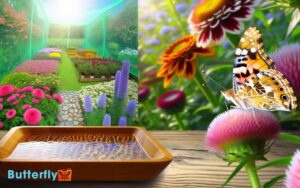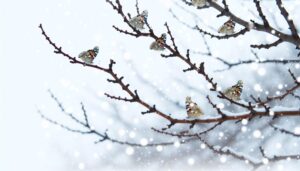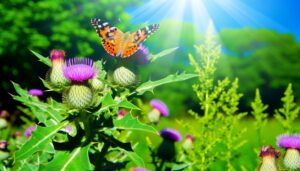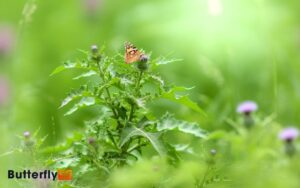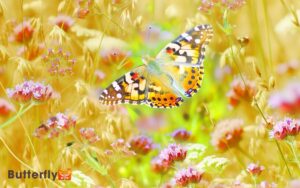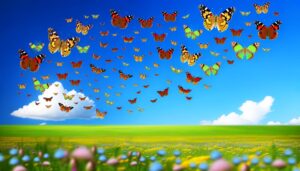Are Painted Lady Butterflies Poisonous? Get the Facts!
Painted Lady butterflies aren’t poisonous to humans or most animals. They exhibit intricate orange and black wing patterns interspersed with white spots, aiding in camouflage and predator deterrence.
With a wingspan ranging from 5 to 9 centimeters, their broad, triangular wings aid in survival within diverse habitats.
Their primary diet comprises nectar from flowering plants like thistles and asters, maintaining diverse ecological interactions. Explore further to understand their fascinating life cycle and ecological roles.
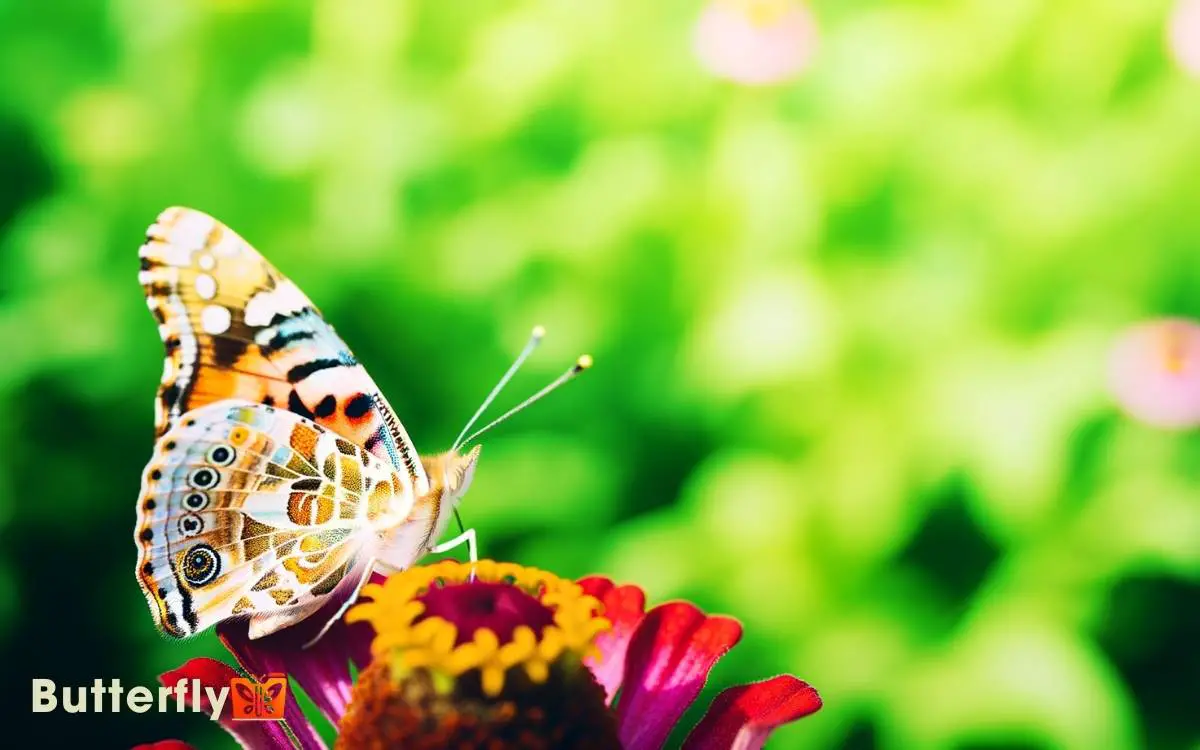
Key Takeaways
What Are Painted Lady Butterflies?
Painted Lady butterflies, scientifically known as Vanessa cardui, are a widely distributed species found on every continent except Antarctica.
These lepidopterans exhibit distinct orange and black wing patterns with white spots, a characteristic aiding in camouflage and predator deterrence. Adult butterflies measure approximately 5-9 centimeters in wingspan.
Their lifecycle consists of four stages: egg, larva (caterpillar), pupa (chrysalis), and adult. Caterpillars primarily feed on thistle plants, while adults favor nectar from various flowers. Vanessa cardui undergoes extensive migratory behaviors, traveling thousands of kilometers.
The species is known for its resilience and adaptability to diverse climatic conditions. Understanding their morphology and life cycle contributes to comprehending their ecological role and evolutionary success.
Habitat and Distribution
Across various continents, Vanessa cardui inhabits a wide range of environments, from temperate meadows to arid deserts, showcasing its extraordinary adaptability.
These butterflies thrive in diverse habitats, including grasslands, gardens, and agricultural fields. Their global distribution spans North America, Europe, Asia, and Africa, making them one of the most cosmopolitan butterfly species.
Observations reveal that Vanessa cardui migrates over long distances, often traveling thousands of miles to find suitable breeding grounds.
They frequently colonize disturbed areas and display a remarkable ability to exploit various host plants for their larvae.
This adaptability not only highlights their resilience but also their capacity to thrive in fluctuating environmental conditions, making them a fascinating subject for ecological and entomological studies.
Physical Characteristics
Painted Lady butterflies exhibit distinct wing patterns and coloration, characterized by orange and black hues with white spots near the tips. They possess a wingspan ranging from 5 to 9 centimeters, with forewings that are slightly angular.
Their antennae are club-shaped, and they’ve six legs, with the front pair being reduced and often held close to the body.
Wing Pattern and Coloration
The intricate wing pattern and vibrant coloration of the Painted Lady butterfly serve as both a camouflage mechanism and a warning signal to predators.
The dorsal side exhibits orange and black patterns with white spots on the forewings, aiding in blending with flowers and foliage.
The ventral side, in contrast, features more subdued hues of brown and gray, providing effective concealment when the butterfly rests with wings closed.
Additionally, the eye spots on the hindwings mimic larger predatory eyes, deterring potential threats.
These visual cues suggest unpalatability, leveraging predator aversion learned from similar patterns in other species.
Therefore, the wing pattern and coloration of the Painted Lady butterfly are essential for survival, balancing concealment and deterrence in their natural habitat.
Size and Shape
Adult Painted Lady butterflies exhibit a wingspan ranging from 5 to 9 centimeters, showcasing a relatively broad and triangular wing shape. Their forewings are distinctively pointed, while the hindwings are more rounded.
The overall body length of an adult butterfly measures approximately 2 to 3 centimeters, contributing to its agile flight capabilities.
The wings, when viewed dorsally, reveal intricate patterns that aid in camouflage and predator deterrence.
| Characteristic | Measurement |
|---|---|
| Wingspan | 5-9 centimeters |
| Forewing Shape | Pointed |
| Hindwing Shape | Rounded |
| Body Length | 2-3 centimeters |
These dimensions, coupled with their vibrant wing patterns, make Painted Lady butterflies easily identifiable in their natural habitats. Their size and shape are evolutionary adaptations that enhance their survival and reproductive success.
Antennae and Legs
Frequently overlooked, their antennae and legs play crucial roles in exploring their environment and ensuring survival.
Painted Lady butterflies utilize their antennae for navigation and sensory perception. These slender structures are covered in chemoreceptors, allowing them to detect pheromones and locate food sources.
Their legs, equipped with taste receptors, enable them to taste potential food by landing on it.
Specifically, the legs serve three primary functions:
- Locomotion: Facilitating movement and stability.
- Sensory Input: Detecting chemical cues from the environment.
- Feeding Assistance: Evaluating the nutritional value of plants.
Life Cycle Overview
Typically, the life cycle of Painted Lady butterflies encompasses four distinct stages: egg, larva, pupa, and adult. Each stage is marked by significant morphological changes. Females lay small, green eggs on host plants.
After approximately 3 to 5 days, larvae (caterpillars) emerge, featuring black spines and yellow banding. They undergo five instars, growing rapidly. The larvae then form a chrysalis, entering the pupal stage, which lasts about 7 to 10 days.
During this period, metamorphosis occurs, transforming the pupa into an adult butterfly. The adult Painted Lady emerges with vibrant orange, black, and white wing patterns.
These butterflies live for approximately two weeks, during which they mate and continue the life cycle.
Diet and Feeding Habits
Upon emerging as adults, Painted Lady butterflies exhibit specific dietary preferences that are essential for their survival and reproduction.
They primarily feed on nectar from a diverse array of flowering plants. This nectar provides important carbohydrates, aiding in energy production and mating activities.
Their dietary habits can be summarized in the following points:
- Nectar Sources: They favor flowers such as thistles, asters, and zinnias, which supply the necessary nutrients.
- Puddling Behavior: Males engage in puddling, absorbing minerals and salts from damp soil, which are essential for reproductive success.
- Larval Food Plants: Caterpillars consume host plants like thistles, mallow, and hollyhocks, necessary for their growth and development.
These feeding behaviors illustrate their adaptive strategies for thriving in various habitats.
Defense Mechanisms
Painted Lady butterflies employ camouflage and mimicry to evade predators, blending seamlessly into their surroundings or resembling less palatable species.
Additionally, they utilize chemical deterrents, secreting toxins that make them unappealing or harmful to potential threats.
These defense mechanisms enhance their survival rates by reducing the likelihood of predation.
Camouflage and Mimicry
Employing intricate patterns and colors, the Painted Lady butterfly utilizes camouflage and mimicry to evade predators. These defense mechanisms enhance their survival in diverse habitats.
Through careful observation, one can identify several key features:
- Wing Patterns: The underside of their wings displays cryptic coloration, blending seamlessly with the environment.
- Mimicry: Painted Ladies resemble other less palatable species, thereby deterring potential threats.
- Behavioral Adaptations: These butterflies often rest with wings closed, presenting less conspicuous patterns.
Chemical Deterrents
Chemical deterrents play an essential role in the Painted Lady butterfly‘s defense strategy by making them unpalatable to predators.
These butterflies sequester toxic compounds called pyrrolizidine alkaloids from the plants they consume during the larval stage. This chemical accumulation renders both larvae and adults distasteful, discouraging predation.
Predators that attempt to consume Painted Ladies often experience adverse reactions, such as nausea, leading to learned avoidance.
Additionally, the butterflies’ bright coloration serves as a visual cue, warning potential predators of their chemical defenses. This aposematic signaling enhances their survival by combining chemical deterrence with visual warnings.
Therefore, Painted Lady butterflies effectively utilize both biochemical and visual strategies to reduce predation, ensuring their continued existence in diverse habitats.
Toxicity in Butterflies
Understanding the toxicity in butterflies involves examining the chemical compounds they sequester from their host plants.
Butterflies, including those in the Nymphalidae family, often accumulate toxins that serve as deterrents against predators. These compounds can vary greatly depending on their diet.
- Alkaloids: Many butterflies sequester alkaloids, which can cause nausea or vomiting in potential predators.
- Cardenolides: Some species store cardenolides, which are potent heart poisons that affect vertebrates.
- Cyanogenic Glycosides: These are converted into hydrogen cyanide, a highly toxic compound, when the insect is attacked.
This chemical defense mechanism is essential for survival. Each compound’s efficacy depends on its concentration and the predator’s sensitivity.
Painted Lady Wing Colors
Painted Lady butterflies exhibit diverse wing color variations, ranging from orange and black to subtle shades of brown and white. These colors can shift based on seasonal changes, with more vibrant hues appearing during warmer months.
Researchers have observed that these variations provide adaptive advantages, influencing both predator avoidance and mating success.
Wing Color Variations
The wing color variations in Painted Lady butterflies exhibit a complex interplay of pigments and structural coloration, creating a spectrum of hues from vibrant oranges to deep browns.
This diversity in coloration results from several factors:
- Pigments: Carotenoids and melanins contribute to the orange and brown shades.
- Structural Colors: Microscopic scales on the wings scatter light, producing iridescence and subtle color shifts.
- Genetic Variability: Differences in genetic makeup lead to unique patterns and intensities of coloration in individual butterflies.
These variations serve multiple purposes, including camouflage against predators and species recognition during mating.
The intricate patterns and colors, while visually stunning, also play essential roles in the butterfly’s survival and reproductive success.
Understanding these variations offers insights into the evolutionary adaptations of this species.
Seasonal Color Changes
How do seasonal changes affect the wing colors of Painted Lady butterflies, leading to observable shifts in pigmentation and pattern intensities?
Seasonal variations, primarily temperature and light, influence the chromatic adjustments in these butterflies. During warmer months, higher temperatures stimulate the production of pigments such as melanins, resulting in darker, more intense hues.
Conversely, cooler temperatures in autumn and winter reduce pigment concentration, yielding lighter and less vibrant wing patterns. Photoperiods also play an essential role; shorter daylight hours trigger physiological changes that reflect in muted colors.
These adaptive modifications enhance camouflage, aiding survival across diverse environments. By comprehending these natural adjustments, one gains deeper insight into the intricate relationship between environmental factors and morphological traits in Painted Lady butterflies.
Are They Poisonous?
Determining the toxicity of Painted Lady butterflies involves examining their diet and chemical composition.
These butterflies primarily consume nectar from various flowers, which generally lacks toxic substances. Additionally, their larvae feed on host plants such as thistles and mallows, also typically non-toxic.
Research has identified three key points about their toxicity:
- Dietary Sources: Painted Ladies don’t ingest significant quantities of toxic compounds from their primary food sources.
- Chemical Analysis: Scientific studies haven’t detected harmful chemicals in their body tissues.
- Behavioral Observations: There are no documented adverse effects in animals or humans upon contact with or ingestion of Painted Lady butterflies.
Predators and Threats
Despite Painted Lady butterflies lacking inherent toxicity, they face various predators and threats in their natural habitats. Birds, spiders, and wasps are primary predators that have a notable impact on their populations.
These butterflies employ defensive behaviors such as erratic flight patterns to evade capture. Additionally, habitat loss and climate change exacerbate their vulnerability.
| Predator | Impact on Population | Defensive Behavior |
|---|---|---|
| Birds | High | Erratic flight patterns |
| Spiders | Moderate | Camouflage |
| Wasps | High | Rapid wing movement |
| Ants | Moderate | Chemical deterrents |
| Frogs | Low | Mimicry |
Understanding these threats is essential for conservation efforts. Painted Lady butterflies rely on a combination of behavioral adaptations and ecological strategies to survive amidst these challenges.
Interaction With Humans
Studying the interaction between Painted Lady butterflies and humans reveals significant insights into their ecological impact and conservation needs. By monitoring population trends and habitat changes, researchers can better understand the painted lady butterfly status and implement conservation efforts accordingly. Citizen science projects also play a crucial role, as public contributions help track migration patterns and environmental influences. Ensuring the preservation of these butterflies benefits not only the species itself but also the broader ecosystem that relies on their pollination activities.
These butterflies are frequently used in educational settings due to their non-poisonous nature and ease of rearing.
This interaction benefits humans in several ways:
- Educational Programs: Painted Ladies are ideal for teaching life cycles and metamorphosis, offering hands-on learning experiences.
- Citizen Science: Their widespread presence makes them perfect candidates for migration tracking projects, engaging the public in scientific research.
- Gardening: They’re attracted to a variety of flowering plants, promoting pollination and enhancing garden biodiversity.
Through these interactions, humans gain a deeper understanding of butterfly biology, fostering a sense of stewardship and the importance of biodiversity conservation.
Role in Ecosystems
Painted Lady butterflies play an essential role in ecosystems by acting as pollinators and serving as prey for various predators, helping to maintain ecological balance.
They visit numerous flowering plants, transferring pollen and aiding in plant reproduction. This pollination activity supports biodiversity and the health of various habitats.
Additionally, their larvae and adult forms provide an important food source for birds, spiders, and other insects. Their widespread presence, from urban gardens to wild meadows, enhances their ecological impact.
By participating in these interactions, Painted Lady butterflies contribute to nutrient cycling and energy flow within ecosystems.
Their migratory patterns also facilitate genetic diversity among plant populations, further bolstering ecosystem resilience and adaptability.
Conservation Status
Given their significant ecological roles, it’s important to evaluate the conservation status of Painted Lady butterflies to guarantee their continued contributions to biodiversity.
Currently, the Painted Lady (Vanessa cardui) isn’t listed as endangered or threatened. However, monitoring their populations is essential due to potential threats like habitat loss, climate change, and pesticide use.
Three key factors need consideration:
- Habitat Preservation: Ensuring the conservation of diverse habitats that support their life cycle stages.
- Climate Change Impact: Understanding how shifts in climate patterns affect their migratory routes and breeding grounds.
- Pesticide Regulation: Implementing stricter controls on pesticide use to mitigate adverse effects on butterfly populations.
Conclusion
In summary, Painted Lady butterflies, while captivating and widespread, aren’t poisonous. Their vibrant colors and erratic flight patterns deter some predators, yet they remain an essential part of the ecosystem.
For example, a study in a Californian meadow found that their larvae played a vital role in plant pollination and served as food for birds.
This dual role highlights their ecological importance, emphasizing the importance of conservation efforts to guarantee their populations remain stable and thriving.

